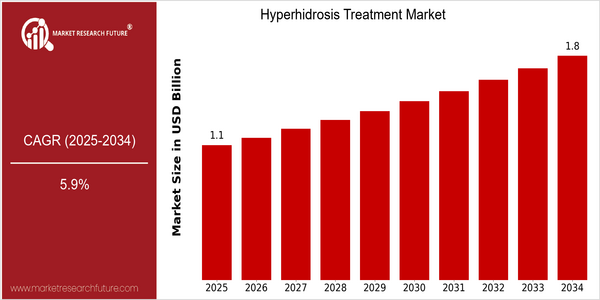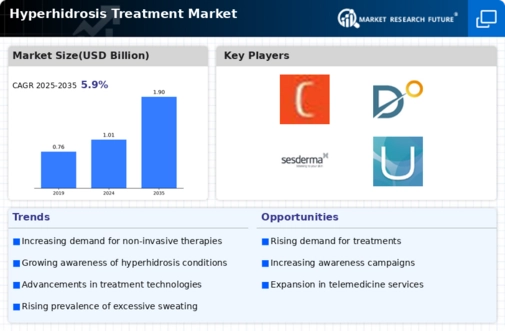Hyperhidrosis Treatment Size
Market Size Snapshot
| Year | Value |
|---|---|
| 2025 | USD 1.07 Billion |
| 2034 | USD 1.79 Billion |
| CAGR (2025-2034) | 5.9 % |
Note – Market size depicts the revenue generated over the financial year
In the meantime, the market for the treatment of hyperhidrosis is booming, with a forecast for 2025 of $1.07 billion, and $1.79 billion by 2034. A compound annual growth rate (CAGR) of 5.9 per cent. The increase in the prevalence of hyperhidrosis, and the increased knowledge and acceptance of treatment, are the main reasons for this. Also, the development of new treatment methods, such as minimally invasive procedures and new topical solutions, further boosts the market. Allergan, Galderma and Ipsen are among the active players in this market, and they are working on strategic initiatives to strengthen their position. This includes collaboration in research and development, investments in clinical trials and the launch of new products that meet the various needs of the patient. These companies are committed to the development of new botulinum toxin formulations and advanced iontophoresis devices, which contribute to the growth of the market.

Regional Market Size
Regional Deep Dive
The hyperhidrosis treatment market is expected to grow at a substantial rate in the coming years, driven by the increasing awareness of the condition and the development of new treatment options. In North America, the market is characterized by a high prevalence of hyperhidrosis and a strong focus on new treatment methods such as botulinum toxin injections and laser treatments. In Europe, the market is characterized by a wide variety of treatments and a growing acceptance of minimally invasive procedures. The Asia-Pacific region is experiencing a high level of demand, driven by the rising purchasing power and the growing awareness of aesthetic treatments. The Middle East and Africa are characterized by a lack of access to modern treatments, but also by a high growth potential, as the healthcare system develops. Latin America is gradually increasing its demand for treatments, which are influenced by cultural attitudes to aesthetics and personal care.
Europe
- The European Medicines Agency (EMA) has streamlined the approval process for new hyperhidrosis treatments, encouraging innovation and faster market entry for new therapies.
- Countries like Germany and the UK are leading in the adoption of advanced laser treatments, with clinics increasingly offering combination therapies that enhance treatment efficacy.
Asia Pacific
- The rise of medical tourism in countries like Thailand and India is boosting the hyperhidrosis treatment market, as patients seek affordable and high-quality care.
- Local companies are developing cost-effective treatment options tailored to the regional market, which is expected to increase accessibility for patients in emerging economies.
Latin America
- Brazil is witnessing a growing trend in aesthetic treatments, including hyperhidrosis therapies, driven by a cultural emphasis on beauty and personal care.
- Local regulatory bodies are beginning to recognize and approve new treatment modalities, which is expected to expand the market and improve patient access.
North America
- The U.S. Food and Drug Administration (FDA) has recently approved new formulations of botulinum toxin specifically for hyperhidrosis, enhancing treatment options for patients and driving market growth.
- Key players like Allergan and Galderma are investing in extensive marketing campaigns to raise awareness about hyperhidrosis, which is expected to increase patient consultations and treatment uptake.
Middle East And Africa
- Healthcare initiatives in the UAE are focusing on improving dermatological services, which is expected to enhance the availability of hyperhidrosis treatments in the region.
- Cultural attitudes towards personal grooming and aesthetics are evolving, leading to increased demand for hyperhidrosis treatments, particularly among younger populations.
Did You Know?
“Approximately 3% of the global population suffers from hyperhidrosis, yet many remain undiagnosed and untreated due to lack of awareness.” — International Hyperhidrosis Society
Segmental Market Size
The hyperhidrosis market is experiencing steady growth, driven by an increasing awareness of the condition and the availability of effective treatment options. The high prevalence of hyperhidrosis, which affects a significant proportion of the population, is also a major growth driver. New treatment options such as botulinum toxin injections and laser therapy are also driving demand. The regulatory support for the development of new therapies is also increasing the market’s momentum, encouraging more companies to invest in research and development. The market is currently at a mature stage of development, with botulinum toxin products from Allergan and Galderma attracting the most interest. The main applications are for treating hyperhidrosis in the clinical setting, primarily underarms, palms and feet. The market is also benefitting from a growing focus on hygiene and self-care, and the influence of telemedicine. Also, the development of new technology, such as iontophoresis and microwave therapy, is shaping the market’s evolution and offering patients a wide choice of treatments that can be tailored to their needs.
Future Outlook
The Hyperhidrosis Market is set to grow significantly from 2025 to 2034. The market is expected to grow at a CAGR of 5.9 per cent from $1.07 billion in 2025 to $1.79 billion in 2034. The main reason for this growth is the increasing awareness of hyperhidrosis as a medical condition, which is leading to an increase in the diagnosis of the disease and a subsequent increase in the use of treatments. Among those diagnosed with hyperhidrosis, the use of treatments is expected to increase from 20 per cent in 2025 to 30 per cent in 2034. The development of new treatment methods, such as minimally invasive procedures and novel drug formulations, is expected to improve the effectiveness of the treatment and the satisfaction of the patient. In addition, supportive regulatory frameworks and an increase in healthcare expenditure in various regions will increase access to these treatments. The use of telemedicine for consultations and follow-ups is also expected to facilitate access to care. The market will evolve, and it is important for all the actors to follow these developments closely in order to be able to benefit from the growing demand for hyperhidrosis treatments.
















Leave a Comment